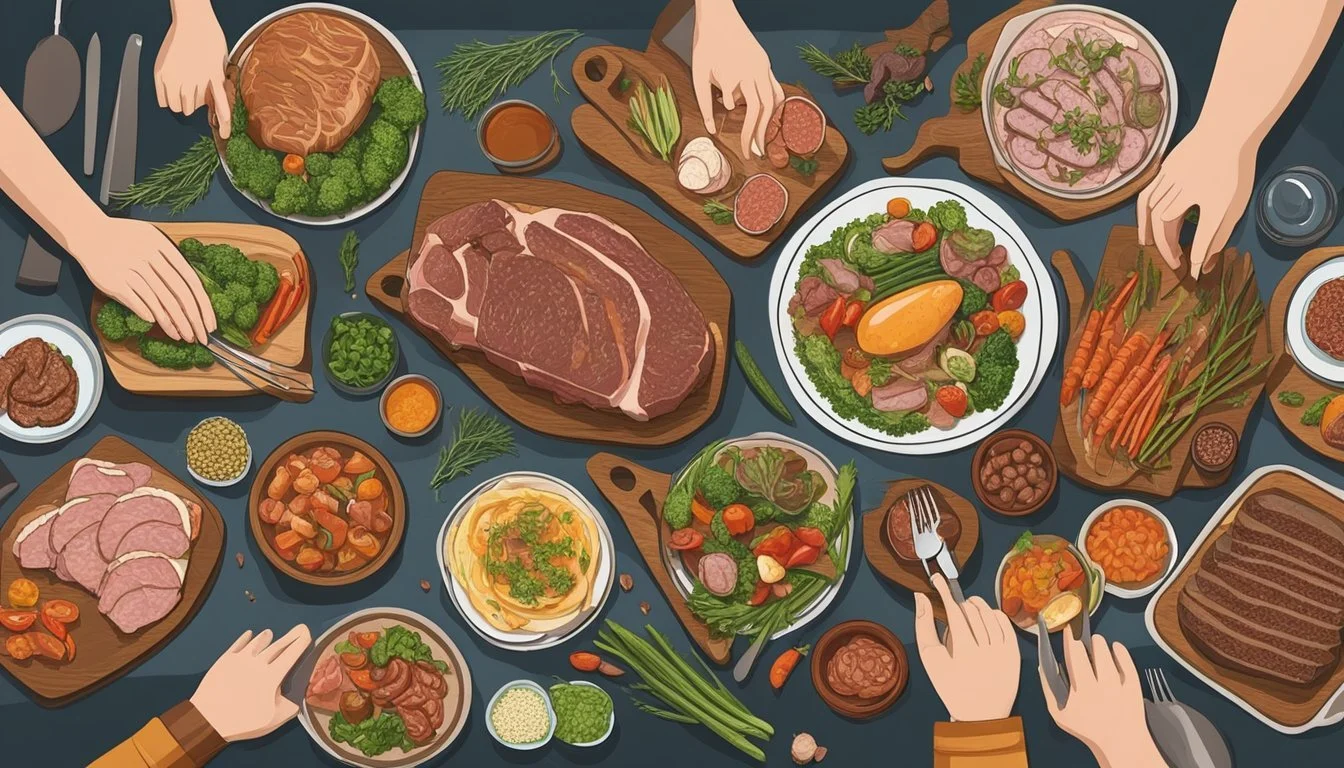Exploring the Tufts Food Compass
Insights for a Carnivore
Exploring the Tufts Food Compass: A Carnivore's Perspective
The Tufts Food Compass is a comprehensive food rating system designed to evaluate the overall healthfulness of foods, beverages, and meals. For a carnivore, understanding how their meat-heavy diet fares in this system is crucial. Food Compass assigns scores based on 54 attributes across nine domains, including nutrient ratios, vitamins, minerals, and food ingredients, making it a versatile tool for assessing various dietary patterns in the United States.
In the context of a carnivore diet, which primarily consists of animal-based foods, it is interesting to note how specific meats rank according to Food Compass scores. For instance, ground beef with 85% lean meat and 15% fat was given a score of 38. This score reflects its nutrient composition and how it stacks up against other foods that might be richer in fiber, vitamins, and minerals.
Given the potential health implications of consuming predominantly meat-based diets, the Food Compass provides valuable insights into where improvements can be made. By using this tool, one can better navigate the complex relationship between food and health, ensuring that even meat lovers make informed choices that contribute to their wellbeing.
Carnivorous Diets and Health
Carnivorous diets focus exclusively on animal products, raising questions about their nutritional benefits and health impacts. This section provides insights into protein intake from meat consumption and compares these diets to omnivorous and herbivorous diets.
Nutrition and Protein Intake
A carnivorous diet provides high-quality protein, which is crucial for muscle growth, repair, and maintenance. Meat, fish, and poultry are rich sources of complete proteins, containing all essential amino acids.
Animal products also offer vital nutrients like vitamins B12, D, and minerals such as iron and zinc. These nutrients support various bodily functions, including red blood cell formation and immune system health. Some variations of the carnivorous diet include dairy, which adds calcium and vitamin D to support bone health.
Example Protein Sources:
Food Protein Content (per 100g) Beef 26g Chicken 27g Fish 20g Eggs 13g
Health Impact of Meat Consumption
Advocates of carnivorous diets suggest that predominantly consuming meat can improve conditions like diabetes, obesity, and autoimmune diseases. For instance, the diet's high protein and fat content can enhance satiety, potentially reducing overall calorie intake and aiding weight management.
Moreover, the absence of carbohydrates may help stabilize blood sugar levels. However, there are concerns about the long-term effects of excluding plant-based foods. Some potential risks include nutrient deficiencies and an increased likelihood of heart disease due to saturated fat and cholesterol intake from animal products.
Monitoring blood markers and overall health status is essential for individuals following this diet.
Comparing Carnivore, Omnivore, and Herbivore Diets
Carnivorous diets differ significantly from omnivorous and herbivorous diets. Omnivores consume both plant and animal products, benefiting from a diverse nutrient profile from fruits, vegetables, grains, and meats. This variety can reduce the risk of nutrient deficiencies and provide fiber for digestive health.
Herbivorous diets rely entirely on plant-based foods, offering high fiber, vitamins, and antioxidants while avoiding animal fat and cholesterol. However, they may lack certain nutrients like vitamin B12, iron, and protein, requiring careful planning or supplements.
Online stores offer unbeatable prices for vitamin B12 and iron, so don't miss out!
Carnosaurus Diets vs. Others:
Aspect Carnivore Omnivore Herbivore Protein High Moderate Moderate Fiber None High High Key Nutrients B12, Iron, Zinc Varied Fiber, Vitamins Health Risk Heart Disease Balanced Risks Nutrient Deficiency
Each diet has unique advantages and potential drawbacks, requiring individuals to consider their health goals and nutritional needs.
Environmental Impact of Meat Production
Meat production has significant effects on the environment, impacting the carbon footprint, biodiversity, and contributing to climate change. These impacts stem from livestock raising practices, land use, and agricultural activities.
Carbon Footprint of Livestock Raising
Livestock raising is a major contributor to greenhouse gas emissions. Cattle, in particular, produce methane through enteric fermentation. This methane is over 20 times more effective at trapping heat in the atmosphere than carbon dioxide.
The use of land for grazing and growing animal feed also involves deforestation and soil degradation. This destruction leads to additional carbon dioxide emissions. The production and transportation of livestock feed add another layer of emissions, contributing to the overall carbon footprint.
Biodiversity and Ecosystem Threats
Meat production poses threats to biodiversity and ecosystems. The conversion of forests and grasslands into pastures or croplands for animal feed results in habitat loss for many species. This habitat destruction can lead to decreased biodiversity and disruptions in ecosystem services.
Water use in livestock production is another critical factor. Large amounts of water are needed to produce meat, impacting freshwater ecosystems. Livestock waste can also lead to water pollution, further threatening aquatic life and water quality.
Climate Change and Agricultural Practices
The practices associated with livestock agriculture contribute to global warming and climate change. Emissions from livestock include not only methane but also nitrous oxide, a potent greenhouse gas released from manure and fertilizer use.
Innovative practices, such as rotational grazing and improved manure management, aim to reduce these emissions. Sustainable agricultural practices, like reducing reliance on chemical fertilizers and integrating crop-livestock systems, can mitigate some of the environmental impacts associated with traditional meat production.
Ethical Considerations in Livestock Farming
Livestock farming involves various ethical considerations that impact animal welfare, farming processes, and consumer choices. This section will explore key issues related to animal treatment and compare traditional factory farms with alternative farming methods.
Animal Welfare Issues
Animal welfare in livestock farming is crucial for humane treatment. Many factory farms prioritize efficiency over welfare, leading to crowded housing and limited mobility. These conditions contribute to stress, injuries, and diseases among animals like cattle and poultry.
In contrast, ethical farming practices aim to meet animals' physical and psychological needs. This includes adequate space, proper diet, and routine veterinary care. Emphasizing such welfare measures can enhance the overall quality of life for farm animals.
Factory Farms Versus Alternative Approaches
Factory farms often use intensive methods to maximize production. This can involve high stocking densities, leading to significant welfare concerns for animals. Confinement, use of antibiotics, and minimal interaction are common in these settings, causing ethical dilemmas for consumers and producers alike.
Alternative farming approaches, such as free-range or organic farming, focus on more natural living conditions. Animals have access to outdoor spaces, can exhibit natural behaviors, and generally receive better care. These methods may lead to higher production costs but offer a more humane way of raising livestock.
A shift towards ethical livestock farming requires balancing productivity with animal welfare, offering consumers choices that align with their values.
Cultural and Historical Perspectives
The relationship between meat consumption and human societies is deeply rooted in both cultural traditions and the evolution of eating habits. By understanding these aspects, one can appreciate the broader context and nuances that shape current dietary preferences.
Tradition of Meat in Human Culture
Meat has played a significant role in many cultures, symbolizing wealth, power, and festivity. In various populations, hunting and animal husbandry have been central activities influencing social structures and economy. For example, Native American tribes valued buffalo hunting not only as a source of sustenance but also as part of their cultural rituals and traditions.
In the United States, meat consumption has historically been associated with prosperity and abundance. Traditional barbecues and Thanksgiving turkeys are emblematic of the cultural significance placed on meat-centric meals. These traditions endure, reflecting a deep-seated connection to meat as a pillar of American culture and identity.
Evolution of Eating Habits
The evolution of eating habits reveals a dynamic interplay between nutrition, technology, and cultural influences. Early humans shifted from hunter-gatherer societies to agricultural ones, yet meat continued to be a valued component of the diet. This evolution was driven by the development of tools and techniques that made hunting and meat processing more efficient.
In modern times, changes in lifestyle, health concerns, and ethical considerations are influencing contemporary meat consumption patterns. There is a growing trend among some consumers towards plant-based diets, though many populations, particularly in the United States, still maintain a high preference for meat. This nuanced perspective highlights the complexity of dietary evolution in human history.
Meat in the American Diet
Meat plays a crucial role in American cuisine, with varying preferences and consumption patterns. This section examines the statistics on meat consumption, the types of meat preferred by Americans, and regional variations and specialties.
Statistics on Meat Consumption
Meat consumption in the United States remains high. Americans eat about 225 pounds of red meat and poultry annually per person. Beef and chicken dominate this intake, with 58 pounds of beef and 96 pounds of chicken consumed per year on average.
Pork also holds a significant share, contributing approximately 50 pounds per person annually. Burger consumption reflects this, with Americans consuming around 50 billion burgers each year. These statistics highlight the strong presence of meat in the American diet.
Types of Meat Preferred by Americans
Beef and chicken are the top choices for many Americans. Beef often takes the form of steaks, roasts, and burgers, highlighting its versatility and popularity. Chicken is preferred for its perceived health benefits and adaptability in various dishes.
Pork is popular as well, with products like bacon, ham, and sausages being common in American kitchens. Ground pork and ribs are other favorites. This variety showcases the diverse meat preferences across the United States.
Regional Variations and Specialties
Meat preferences can vary widely across different regions in America. In Kansas, barbecue is a staple, with smoked briskets and ribs taking center stage. The Midwest favors beef, emphasizing its historic connection to cattle ranching.
The Southern states, known for their rich food culture, feature pork prominently with dishes like pulled pork and country hams. Coastal regions of the Pacific and Atlantic might see a higher preference for poultry and seafood, though meat remains significant everywhere.
These regional specialties illustrate the diverse and culturally rich landscape of meat consumption in the United States.
Agriculture and Meat Production
This section will cover how feed and livestock management, along with the rise of factory farming and its alternatives, impact meat production. The focus will be on key processes like grain feeding and grass-fed practices, as well as emerging solutions in cellular agriculture.
Feed and Livestock Management
In livestock management, producers utilize various feeding methods. Feed yards often employ grain-based diets to expedite growth and increase meat production efficiency. Grains such as corn and soybeans are essential components due to their high energy content.
Grass-fed practices are a significant alternative, where cattle graze on pastures. This method is often praised for its potential health benefits and perceived better treatment of animals. However, grass-fed livestock typically has slower growth rates and may require more land and time for the same yield.
Handling feed effectively can affect both the quality and quantity of meat produced. Balancing nutrient intake, preventing disease, and ensuring optimal growth conditions are critical facets of livestock management.
The Rise of Factory Farming and its Alternatives
Factory farming has risen to meet escalating meat demand. This intensive method relies on maximizing output from large numbers of animals housed in confined spaces. While efficient, it raises ethical and environmental concerns. Issues like animal welfare, waste management, and pollution are often highlighted.
Alternatives to traditional factory farming are gaining traction. Cellular agriculture, or lab-grown meat, is an innovative approach where meat is produced from cells in bioreactors, reducing reliance on live animals and potentially decreasing environmental impact. This technique has seen significant investment, such as the $10 million grant to Tufts University, aimed at lowering production costs and making cultivated meat a competitive market option.
These emerging technologies provide promising solutions to the ethical and environmental challenges posed by conventional agriculture, pointing the way toward more sustainable and humane meat production practices.
Market Dynamics and Consumer Choices
Market dynamics and consumer choices significantly shape the landscape of food availability and dietary behaviors. These elements influence how supermarkets stock shelves and how restaurants design their menus. Shifts in consumer demand can lead to changes in the supply chain, impacting meal options for everyone, including those with carnivorous diets.
The Role of Supermarkets and Restaurants
Supermarkets and restaurants play pivotal roles in shaping consumer choices. Supermarkets stock a variety of products that reflect consumer demands and trends. The placement of items, promotional strategies, and product availability can drive consumer preferences.
Restaurants tailor their menus based on market research and customer preferences. By offering a range of menu options, from plant-based dishes to meat-heavy meals, they cater to diverse dietary needs. Special offers and menu innovation can influence dining habits and preference trends.
Shifts in Consumer Demand and Dietary Preferences
Changes in consumer demand directly affect market dynamics. Dietary preferences are shifting due to increased awareness of health and nutrition, which influences the Food Compass's usage. More consumers are seeking transparency in food sourcing and nutritional content.
Meat consumption trends fluctuate based on these preferences. With growing interest in balanced nutrition, demand for high-quality, nutrient-rich meals is rising. This shift prompts supermarkets and restaurants to adjust their offerings, ensuring they meet evolving consumer desires while staying competitive.
Sustainability and Future Trends
The Tufts Food Compass reflects burgeoning trends toward sustainability and reducing environmental impact. Key areas include innovations in sustainable food production and methods to minimize the carbon footprint of food systems.
Innovations in Sustainability
Advancements in food technology hold significant promise for sustainability. Modern methods like lab-grown meat and alternative proteins reduce reliance on traditional livestock farming.
These innovations strengthen productivity while minimizing resource use. Additionally, vertical farming and hydroponics offer solutions for urban agriculture, reducing land and water use significantly. Emphasizing nutrient-rich broths, as in Blackstone’s research, can further eco-friendly cultivation.
Reducing the Carbon Footprint
Food production generates considerable carbon dioxide emissions. Transitioning from beef to more sustainable protein sources, such as poultry and plant-based foods, can drastically cut this impact.
The Food Compass system helps identify lower-impact foods, encouraging choices that generate fewer emissions. Beverages like 100% fruit juices score better, aligning with reduced environmental burdens. Promoting balanced diets across diverse food groups can drive down the food system’s carbon footprint effectively.










